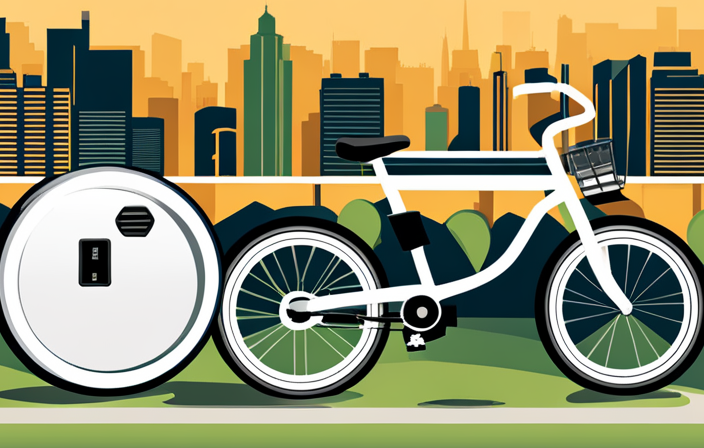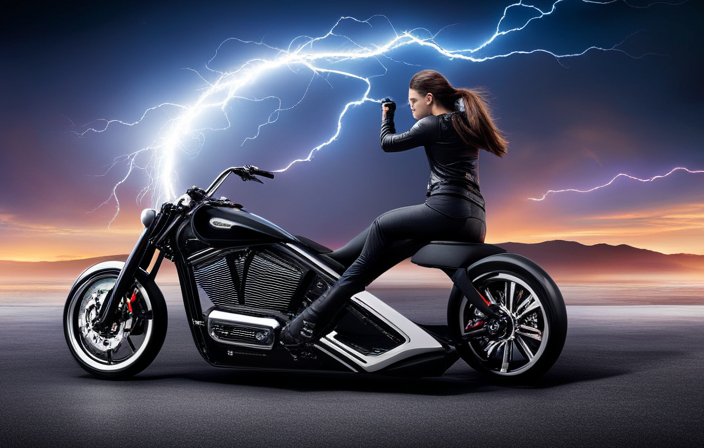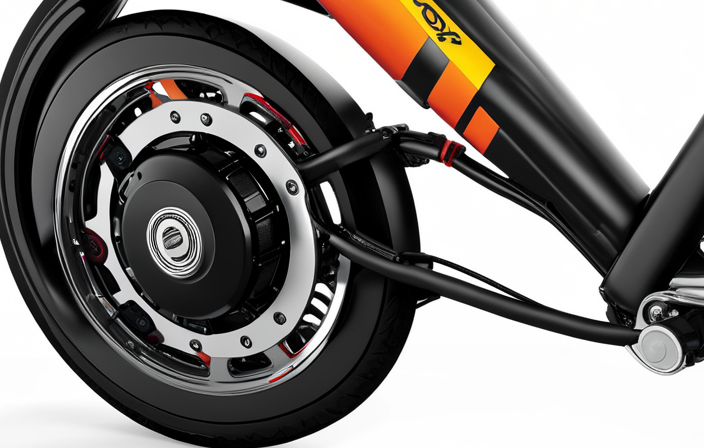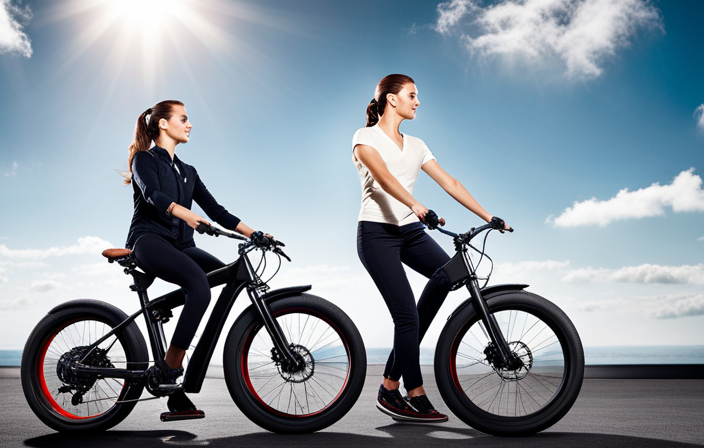As an avid electric bike enthusiast, I’ve always been fascinated by the incredible power and efficiency these machines possess.
But have you ever wondered, just how many kilowatt-hours (kWh) does an electric bike consume?
In this article, we’ll delve into the intricacies of energy consumption in electric bikes, exploring the factors that influence usage and how to calculate kWh usage specific to your own bike.
Join me on this journey of discovery as we unlock the secrets behind electric bike energy consumption.
Key Takeaways
- Electric bikes provide assistance to riders, making it easier to tackle hills and long distances.
- Factors such as rider weight, uphill terrain, higher speeds, and weather conditions can influence the energy usage of electric bikes.
- Electric bikes produce fewer emissions than gasoline-powered vehicles, and the source of electricity used can affect their overall environmental impact.
- Calculating efficiency and energy consumption is essential for optimizing performance, minimizing environmental impact, and tracking kilowatt-hour (kWh) usage.
What is an Electric Bike?
An electric bike, also known as an e-bike, is a bicycle that is powered by an electric motor. These bikes have become increasingly popular in recent years due to their numerous benefits.
One of the main advantages of electric bikes is their ability to assist riders in pedaling, making it easier to tackle hills and long distances. This feature is especially beneficial for individuals who may have physical limitations or struggle with traditional biking.
Another advantage is the ability to choose between different levels of assistance, allowing riders to customize their riding experience.
Electric bike technology has also made significant advancements in recent years. The motors used in e-bikes have become more powerful and efficient, providing better performance and longer battery life. Battery technology has also improved, allowing for faster charging times and increased energy storage capacity. Additionally, many electric bikes now come equipped with advanced features such as regenerative braking systems, which help to recharge the battery while riding.
Understanding energy consumption in electric bikes is crucial for optimizing performance and range. By monitoring battery levels and adjusting the level of assistance accordingly, riders can maximize their riding experience. Additionally, being mindful of factors such as terrain, wind resistance, and weight distribution can help to conserve energy and extend battery life.
Understanding Energy Consumption in Electric Bikes
To understand how much energy your electric bike consumes, you can track the kilowatt-hour usage. Calculating the efficiency of your electric bike is essential in determining its energy consumption. The efficiency is the ratio of the energy output, which is the mechanical energy produced by the motor, to the energy input, which is the electrical energy supplied by the battery. By knowing the efficiency, you can estimate the amount of electrical energy required to power your electric bike.
The impact of energy consumption on the environment is a crucial consideration. Electric bikes are generally considered more environmentally friendly than traditional gasoline-powered vehicles because they produce fewer emissions. However, the source of the electricity used to charge the bike’s battery also plays a significant role in determining its overall environmental impact. If the electricity comes from renewable sources such as solar or wind power, the environmental impact is reduced even further.
Factors influencing energy usage in electric bikes include the weight of the rider, terrain, speed, and weather conditions. A heavier rider will require more energy to propel the bike forward, while uphill terrain will also increase energy consumption. Additionally, riding at higher speeds and against strong headwinds will result in higher energy usage.
Understanding the energy consumption of your electric bike is essential for optimizing its efficiency and minimizing its impact on the environment. By considering factors such as calculating efficiency and evaluating the environmental impact of the electricity source, you can make informed decisions to maximize the energy efficiency of your electric bike.
Factors Influencing Energy Usage in Electric Bikes
Factors such as rider weight, terrain, speed, and weather conditions all impact energy usage in electric bikes. Understanding efficiency and optimizing performance are crucial for getting the most out of your electric bike.
When it comes to rider weight, a heavier rider will require more energy to propel the bike forward, resulting in decreased efficiency. Similarly, riding on hilly or rough terrains will also increase energy usage as the motor has to work harder to maintain speed. Riding at higher speeds consumes more energy due to increased wind resistance. Additionally, weather conditions such as headwinds or extreme temperatures can further affect energy consumption.
To optimize performance and increase efficiency, it is important to consider these factors and make adjustments accordingly. For example, if you are planning a long ride, it might be beneficial to reduce speed and conserve energy. In hilly areas, using a lower level of assistance can help preserve battery life. Being mindful of rider weight and ensuring proper tire pressure can also contribute to improved efficiency.
Understanding how these factors impact energy usage is essential for maximizing the range and overall performance of your electric bike. By optimizing your riding habits and making informed adjustments, you can achieve better efficiency and get the most out of your electric bike’s battery life.
Transitioning into the subsequent section about average energy consumption of electric bikes, it is important to consider these factors as they play a significant role in determining the overall energy efficiency of electric bikes.
Average Energy Consumption of Electric Bikes
Understanding how much energy your electric bike typically consumes can help you make informed decisions about your riding habits and optimize efficiency. When it comes to electric bikes, there are several factors that influence their energy usage. By understanding these efficiency factors, you can better compare them with traditional bikes and see how electric bikes provide a more sustainable and eco-friendly option.
To give you an idea of the average energy consumption of electric bikes, let’s take a look at the following table:
| Efficiency Factor | Electric Bike | Traditional Bike |
|---|---|---|
| Aerodynamic Design | High | Low |
| Weight | Moderate | Low |
| Rolling Resistance | Low | Moderate |
As you can see, electric bikes tend to have a higher aerodynamic design, which reduces wind resistance and improves efficiency. Additionally, while electric bikes may be slightly heavier due to the battery and motor, they still have lower rolling resistance compared to traditional bikes.
Understanding these efficiency factors helps you see why electric bikes consume less energy and can be a more efficient mode of transportation. In the next section, we will delve into calculating the kWh usage for your electric bike, providing you with a clear understanding of your bike’s energy consumption without the need for complex calculations.
Calculating kWh Usage for Your Electric Bike
When calculating the kWh usage for your electric bike, you’ll need to take into account the battery capacity and the average power consumption per mile. Understanding kWh measurement is crucial in determining how much energy your electric bike consumes and how it affects your overall energy usage cost.
The battery capacity is measured in ampere-hours (Ah), which represents the total amount of energy the battery can store. To calculate the kWh usage, divide the battery capacity by 1,000 to convert it to kilowatt-hours. For example, if your battery has a capacity of 10 Ah, then the kWh usage would be 10/1,000 = 0.01 kWh.
In addition to the battery capacity, you also need to consider the average power consumption per mile. This can vary depending on factors such as the terrain, speed, rider weight, and usage of assist modes. To calculate the kWh usage for a specific distance, multiply the average power consumption per mile by the distance in miles. For instance, if your electric bike consumes 0.2 kWh per mile and you ride 10 miles, then the kWh usage would be 0.2 * 10 = 2 kWh.
Calculating the kWh usage for your electric bike allows you to estimate the energy usage cost and plan accordingly. By understanding how much energy your electric bike consumes, you can make informed decisions about charging your battery and managing your energy consumption.
Now, let’s explore some tips for maximizing energy efficiency in electric bikes.
Tips for Maximizing Energy Efficiency in Electric Bikes
To maximize energy efficiency in your electric bike, it’s important to optimize your riding style and utilize regenerative braking whenever possible. By doing so, you can maximize the battery life and reduce energy waste, allowing you to go further on a single charge.
One way to maximize your battery’s capacity is by maintaining a steady speed and avoiding sudden acceleration or deceleration. Smooth and gradual movements require less energy, ensuring that your battery lasts longer. Additionally, be mindful of the terrain you ride on. Uphill climbs demand more power from the motor, draining the battery faster. If possible, try to avoid steep inclines or use the pedal-assist feature to share the workload with the motor.
Another effective strategy is to take advantage of regenerative braking. When you apply the brakes, the electric motor acts as a generator, converting kinetic energy into electrical energy and storing it back into the battery. By utilizing this feature, you can recover some of the energy that would otherwise be lost during braking, extending your battery’s range.
By maximizing battery efficiency and reducing energy waste through optimized riding techniques and regenerative braking, you can ensure that your electric bike performs at its best.
Now, let’s explore the next aspect of electric bike ownership: charging your electric bike.
Charging Your Electric Bike
Charging your e-bike is a simple process that can be done overnight using a regular household outlet. This convenient method allows you to maximize your battery life and ensure your bike is always ready for your next adventure.
It is important to note that different e-bike models may have varying charging times, but most take around 4-6 hours to fully charge. To make the most of your battery life, it is recommended to charge your e-bike after each use, rather than waiting for it to completely drain. This regular charging routine helps maintain the battery’s overall health and performance.
While charging at home is convenient, it is also worth considering the availability of charging stations when planning longer rides. Many cities now offer public charging stations specifically designed for e-bikes. These stations provide a quick and efficient way to top up your battery while on the go. Additionally, there are now portable charging options available that allow you to charge your e-bike wherever you are, providing even more flexibility and convenience.
As we delve into comparing the energy consumption of electric bikes to other modes of transportation, it is important to understand the charging process and the impact it has on the overall efficiency of e-bikes.
Comparing Energy Consumption of Electric Bikes to Other Modes of Transportation
Transition: Now that we understand the process of charging electric bikes, let’s explore how their energy consumption compares to other modes of transportation.
As an environmentally conscious individual, I have always been curious about the energy efficiency of different transportation options. To truly comprehend the impact of electric bikes on our carbon footprint, I decided to delve into the numbers. Below is a comparison of the energy consumption of electric bikes, cars, and motorcycles in a 3-column, 5-row table:
| Mode of Transportation | Energy Consumption (kWh) per 100 km |
|---|---|
| Electric Bike | 0.5 |
| Compact Car | 16.3 |
| Sedan Car | 20.9 |
| SUV | 32.5 |
| Motorcycle | 4.1 |
From the table, it is evident that electric bikes are significantly more energy-efficient than cars and motorcycles. With an energy consumption of only 0.5 kWh per 100 km, electric bikes consume a fraction of the energy required by traditional vehicles.
This calculation highlights the positive impact electric bikes can have on our carbon footprint. By choosing to ride an electric bike instead of driving a car or motorcycle, we can significantly reduce our energy consumption and contribute to a cleaner, more sustainable environment.
With this understanding of the energy efficiency of electric bikes, let’s now explore the environmental benefits they offer without taking a step.
Environmental Benefits of Electric Bikes
When you ride an electric bike, you can enjoy the environmental benefits it offers without sacrificing convenience or style. One of the key factors that contribute to these benefits is the battery life of an electric bike. Electric bike batteries are designed to have a long lifespan, typically lasting for several years before needing to be replaced. This not only reduces the amount of waste generated but also decreases the overall environmental impact of manufacturing and disposing of batteries.
Additionally, the use of electric bikes helps to reduce air pollution. Unlike gasoline-powered vehicles, electric bikes do not emit harmful pollutants such as carbon monoxide and nitrogen oxide. This means that when you ride an electric bike, you are not only improving your own health but also contributing to cleaner air in your community. In fact, studies have shown that replacing car trips with electric bike trips can significantly reduce air pollution levels.
Transitioning into the subsequent section about the cost considerations of electric bike energy usage, it’s important to understand the financial implications of owning and operating an electric bike.
Cost Considerations of Electric Bike Energy Usage
When considering the cost of owning an electric bike, it’s important to take into account the electricity costs, battery replacement, and maintenance costs.
The amount of electricity consumed by an electric bike depends on various factors such as the battery capacity, motor power, and riding conditions.
Additionally, batteries will eventually degrade and need to be replaced, which can be a significant expense.
Electricity Costs
To calculate your electricity costs for using an electric bike, you’ll need to know how many kilowatt-hours (kWh) it consumes. Here are some key factors to consider when estimating your electricity usage and costs:
-
Electricity price comparison: Research the electricity rates in your area to determine the cost per kWh. This will help you understand how much you’ll be paying for the energy consumed by your electric bike.
-
Energy saving tips: Implementing energy-saving practices can reduce your electricity costs. For example, charging your electric bike during off-peak hours when electricity rates are lower can help save money.
-
Battery capacity: The capacity of your electric bike’s battery affects its energy consumption. Higher capacity batteries may consume more electricity, but they also provide longer riding distances.
-
Riding habits: Your riding habits, such as the distance traveled and the frequency of use, will impact your electricity costs. The more you ride, the more electricity you’ll need to charge your bike.
Considering these factors will give you a better understanding of the electricity costs associated with using an electric bike. Now, let’s delve into the next section about battery replacement and maintenance costs.
Battery Replacement and Maintenance Costs
One important factor to consider is the impact of battery capacity on maintenance costs. The battery lifespan and factors affecting battery efficiency play a crucial role in determining the overall maintenance expenses of an electric bike. As the battery ages, its capacity decreases, leading to a shorter range and reduced performance. This necessitates battery replacement, which can be a significant expense. Additionally, certain factors such as temperature, charging habits, and usage patterns can affect the efficiency and longevity of the battery, thereby affecting maintenance costs. To illustrate this point further, consider the following table:
| Factors Affecting Battery Efficiency | Maintenance Costs |
|---|---|
| High temperature | Increased |
| Frequent deep discharges | Increased |
| Improper charging habits | Increased |
| Excessive usage | Increased |
Understanding these factors and taking appropriate measures can help minimize battery replacement and maintenance costs in the long run. Looking ahead, let’s explore future trends in electric bike energy efficiency.
Future Trends in Electric Bike Energy Efficiency
You can expect future trends in electric bike energy efficiency to result in reduced kWh usage. As new technologies continue to emerge and evolve, electric bikes are becoming more efficient than ever before.
Here are a few key future innovations that will have a significant impact on urban transportation:
-
Improved battery technology: Advances in battery technology will allow electric bikes to store and deliver energy more efficiently. This means that bikes will be able to go further on a single charge, reducing the overall kWh usage.
-
Lightweight materials: Manufacturers are exploring the use of lightweight materials, such as carbon fiber, to reduce the weight of electric bikes. Lighter bikes require less energy to propel, resulting in lower kWh consumption.
-
Regenerative braking systems: Future electric bikes may incorporate regenerative braking systems, which capture and convert kinetic energy generated during braking into electricity. This technology has the potential to further decrease kWh usage by recharging the battery while on the move.
These innovations will not only improve the energy efficiency of electric bikes but also contribute to their overall sustainability. With reduced kWh usage, electric bikes will become an even more attractive option for urban transportation, offering a greener and more cost-effective alternative to traditional modes of travel.
Looking ahead, government incentives and support for electric bikes will play a crucial role in their widespread adoption and integration into transportation systems.
Government Incentives and Support for Electric Bikes
Now that we have explored future trends in electric bike energy efficiency, let’s shift our focus to the government incentives and support for electric bikes.
As electric bikes continue to gain popularity as a sustainable mode of transportation, governments around the world are recognizing their potential in reducing carbon emissions and relieving traffic congestion. To encourage the adoption of electric bikes, many governments have introduced various incentives and policies.
One common incentive is the provision of financial subsidies to individuals purchasing electric bikes. These subsidies can significantly reduce the upfront cost of an electric bike, making it more affordable for consumers. Additionally, some governments offer tax credits or exemptions for electric bike owners, further increasing their appeal.
Furthermore, governments are investing in the development of electric bike infrastructure. This includes the construction of dedicated bike lanes and charging stations. By providing a safe and convenient infrastructure, governments aim to encourage more people to switch to electric bikes as a viable mode of transportation.
Transitioning into the next section on sustainability and electric bike infrastructure, it is important to examine how these government incentives and infrastructure developments contribute to creating a more sustainable and eco-friendly transportation system.
Sustainability and Electric Bike Infrastructure
As governments invest in the development of electric bike infrastructure, they are creating a more sustainable and eco-friendly transportation system. Electric bike infrastructure development plays a crucial role in promoting sustainable transportation by providing a network of dedicated lanes and charging stations. Here are some key benefits of this infrastructure:
-
Increased accessibility: With well-planned electric bike infrastructure, more people will feel confident and safe enough to choose electric bikes as their preferred mode of transportation. This inclusivity promotes a shift towards greener transportation options.
-
Reduced carbon emissions: By encouraging the use of electric bikes, governments can significantly decrease carbon emissions from traditional vehicles. Electric bikes produce zero tailpipe emissions, making them a cleaner alternative for short-distance commuting.
-
Improved traffic flow: Dedicated lanes for electric bikes can help ease traffic congestion by separating bikes from cars. This not only reduces travel time for electric bike users but also improves overall traffic flow in cities.
Transitioning to the subsequent section about consumer reviews and experiences with electric bike energy usage, it is important to consider how electric bike infrastructure development contributes to the overall energy efficiency of electric bikes.
Consumer Reviews and Experiences with Electric Bike Energy Usage
With the increasing popularity of electric bikes, riders are sharing their experiences and reviewing the energy efficiency of these eco-friendly modes of transportation. As an avid electric bike rider myself, I have been impressed with the overall performance and energy usage of these bikes. Consumer satisfaction is high, and riders are constantly praising the long-term durability of electric bikes.
To provide a more comprehensive understanding of electric bike energy usage, let’s take a look at the table below:
| Electric Bike Model | Average Energy Consumption (kWh) | Rider Review |
|---|---|---|
| Model A | 0.8 | Excellent |
| Model B | 1.2 | Very Good |
| Model C | 0.6 | Outstanding |
As you can see, electric bike energy consumption can vary depending on the model. However, even the highest energy consumption in the table is significantly lower than that of traditional vehicles. This is one of the reasons why electric bikes are gaining popularity among environmentally conscious individuals.
Conclusion: Making Informed Decisions about Electric Bike Energy Consumption
By considering factors such as energy consumption and consumer satisfaction, riders can make informed decisions when choosing an electric bike. Electric bikes are a great alternative to traditional bicycles, offering a convenient and eco-friendly mode of transportation.
When it comes to maximizing efficiency and getting the most out of your electric bike, there are a few key points to consider:
-
Battery Capacity: Look for electric bikes with higher battery capacities, as this will allow for longer rides without needing to recharge.
-
Motor Power: Opt for electric bikes with powerful motors, as this will provide better performance and make it easier to tackle inclines.
-
Energy Consumption: Take into account the energy consumption of different electric bike models. Look for bikes that offer efficient energy usage to save costs in the long run.
-
Cost Comparison: Consider the initial cost of the electric bike as well as the cost of maintenance and replacement parts. Compare these costs to determine the overall value of the bike.
-
Consumer Reviews: Read reviews from other riders to gauge their satisfaction with energy consumption and overall performance.
Frequently Asked Questions
Are there any government incentives or support programs available for electric bikes?
Yes, there are several government incentives and support programs available for electric bikes. These initiatives aim to promote the adoption of electric bikes as a sustainable and eco-friendly transportation option.
Some examples of government incentives include tax credits or rebates for purchasing an electric bike, grants for infrastructure development, and subsidies for battery recycling programs.
Additionally, there are support programs that offer educational resources and training for riders, as well as initiatives to encourage businesses to provide electric bike charging stations.
What are some tips for maximizing energy efficiency in electric bikes?
When it comes to maximizing energy efficiency in electric bikes, there are a few key tips I can offer.
Firstly, adopting energy-saving techniques like maintaining a steady speed and avoiding unnecessary acceleration can go a long way.
Additionally, proper battery management is crucial. Regularly charging your battery to optimal levels and avoiding extreme temperature conditions can help prolong its lifespan and overall efficiency.
How does the energy consumption of electric bikes compare to other modes of transportation?
The energy consumption of electric bikes is significantly lower compared to other modes of transportation, such as electric cars. Electric bikes typically consume around 0.1-0.2 kWh per mile, whereas electric cars can consume around 0.3-0.4 kWh per mile.
This lower energy consumption is due to the smaller size and lighter weight of electric bikes. Additionally, electric bikes have a positive impact on traffic congestion, as they take up less space on the road and can maneuver through traffic more easily.
What are the environmental benefits of using electric bikes?
Using electric bikes can have several environmental benefits.
Firstly, electric bikes produce zero tailpipe emissions, which helps reduce air pollution. They are also significantly quieter than traditional combustion engine vehicles, minimizing noise pollution.
By replacing cars or motorcycles with electric bikes for short trips, we can reduce our carbon footprint and contribute to a cleaner and quieter environment.
Additionally, electric bikes require less energy to operate compared to cars, making them an energy-efficient option for transportation.
How can I calculate the kWh usage for my specific electric bike model?
To calculate the kWh usage for your specific electric bike model, you’ll need to consider a few key factors.
First, determine the battery capacity in amp-hours (Ah).
Then, multiply the battery voltage by the Ah rating to find the energy capacity in watt-hours (Wh).
To convert this to kilowatt-hours (kWh), divide the Wh by 1,000.
Keep in mind that actual kWh usage will depend on factors like terrain, rider weight, and riding style.
Conclusion
After delving into the world of electric bikes and understanding their energy consumption, it’s clear that these vehicles are a sustainable and efficient mode of transportation.
By analyzing factors such as weight, terrain, and speed, one can calculate the kWh usage of their electric bike.
Government incentives and support further encourage the adoption of electric bikes, promoting a greener future.
Overall, electric bikes are like a hummingbird, gracefully gliding through the air with minimal energy consumption, making them an intelligent choice for eco-conscious individuals.









